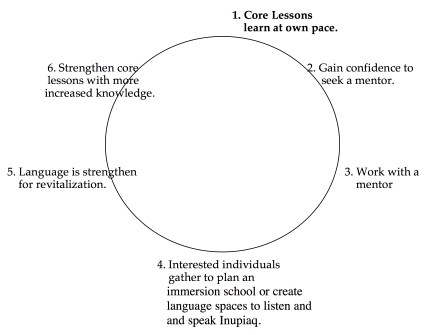 "Ugiuvaŋmiuraaqtuaksrat" "Ugiuvaŋmiuraaqtuaksrat"
Future King Island Speakers
Chapter 4
Steve Krashen's Theory of Second Language Acquisition
There are many and varied
theories in first and second language learning. When I first began studying
some of these
theories in the early 1990's, I related
fairly well with the work of Stephen D.
Krashen on theory of second language acquisition. I have included very basic
information on his work. I like
his idea of utilizing the best resource
there
is for language acquisition – the
native speakers themselves! The theory
will be discussed before the model for strengthening Inupiaq through
the recorded
lessons.
In 1982, Krashen published a book titled, "Principles and
Practice in Second Language Acquisition". His theory of acquiring
language has five
hypotheses:
• The Acquisition-Learning Distinction
• The Natural Order Hypothesis
• The Monitor Hypothesis
• The Input Hypothesis
• The Affective Filter Hypothesis
The following is a very brief summary
of the hypotheses and how they relate to the proposed "Ugiuvaŋmiuraaqtuaksrat
Lessons"
Krashen recommends using speakers of
the language to learn how to communicate.
He
says that "language acquisition
occurs when language is used for what
it was designed for, communication" (p.
1). Various individuals have
learned to speak Inupiaq amongst the
King Islanders. The Little Sister of
Jesus,
a Catholic order of nuns, used to visit
my mother to learn Inupiaq from her.
They used to
take notes while they repeated words
after my mother. In the early 1960's
a marine biologist with Alaska Department
of Fish and Game,
John Burns,
did the same thing. He learned Inupiaq
while working and hunting with the King
Island
men out on the Bering Sea. These individuals
wanted to learn to communicate in Inupiaq
so they acquired the language from the
speakers of the language.
The first hypothesis
is, "The Acquisition-Learning Distinction," Krashen
speaks about the difference between the
acquisition and learning of language.
Much like the "traditional way" (in
a Native community) of learning
a language, he stated, "language
acquirers are not usually aware of the
fact that they are acquiring language,
but are only aware of the
fact
that they are using the language for
communication. The result of language
acquisition,
acquired competence is also unconscious" (p.
10). Whereas in learning the language,
it is a conscious process of knowledge.
It is about knowing
the
grammatical
rules, "being aware of them and
being able to talk about them" (p.
10). To Krashen, this is not as important
as acquiring language. It is more important
to communicate in the language.
In Krashen's
thinking, adults can access the same
natural "language
acquisition device", like children, "acquisition
is very powerful process in the adult" (p.
10). So, it is possible for adults to
acquire language like children. The recorded
tapes can help with that process
of learning the words then practice the
words with a fluent speaker.
The second
hypothesis is, "The Natural Order
Hypothesis." It is about
individuals learning the grammatical
structure of the language. Krashen give
examples in English where morphology
was most studied. Individuals
learn at a
different pace as to how they would learn
the grammar of a language. Some will
take longer while another learns at an
early age. This is
where the
"baby
language" fits in. Children are
given one-word expressions and/or commands.
These are shortened words so very small
children can begin understanding Inupiaq
language. They begin learning the grammatical
structure at
a young age and are
able to move on the complete sentences
as they become older.
The third hypothesis
is "The Monitor Hypotheses." This
has to do with the relationship between
the acquisition and learning of language.
The monitor is like an editor of what
is being learned (grammatical
structure), while acquisition
is the ‘utterance initiator'. Krashen
gives different suggestions on ‘monitor'
use. The over-users are those who use
the ‘monitor' all
the time. The under-users are those who
have not learned or prefer not to use
their conscious knowledge. The optimal
user is the one who uses the ‘monitor'
appropriately all the time.
The fourth
hypothesis is, "The Input Hypothesis." This
is about moving from one stage to another.
Krashen asks, how does one move to the
next
stage of learning? He explains as "i" being
information that is known and then adding
more to the next step, which would be
represented as
"+1".
So the input hypothesis is "i+1".
The added understanding is through linguistic
competence and through context. "Comprehensible
input" is
provided to gain fluency in a language.
A caretaker's speech to a child is modified
so the child can understand what is being
said. As time
progresses, the words become more complex.
The common expressions become a full
sentences
as the child grows older, motions are
added for "comprehensible input."
Where
observation is inherent in the Inupiaq
language, it is akin to "the
explanation of the silent period in terms
of the input hypothesis is straight forward – the
child is building up competence in the
second language via listening, by understanding the language around
him" (p. 27).
The fifth hypothesis is "The Affective Filter Hypothesis." Krashen
explains that there are variables,
which contribute to success in acquiring language:
- Motivation – individuals
with high motivation do better.
- Self-confidence – individuals
with good self-confidence or good self-image do better.
- Anxiety – less
anxiety is better for language acquisition.
Krashen
states it well when he says, "The effective language teacher
is someone who can provide input
and help make it comprehensible in a low
anxiety situation" (p. 32).
A sympathetic mentor is such a teacher!
Native elders
and cultural experts have always
taught in this manner.
Krashen continues
about the different approaches to
teaching languages
and how they relate
to his theory
of acquiring
a second language.
The newer approaches
he talks about were James Asher's
Total Physical Response (TPR) and
Tracy Terrell's
Natural
Approach for language
instruction. These
approaches have had good reviews
with various indigenous communities.
As an Inupiaq
Bilingual
Teacher at Nome Public Schools, I
have
tried Asher's TPR methods but have
always fallen
short on commands
after
a while. It
was difficult to move
onto regular sentences. The movement
was good for the children but at
college level,
the adults did not really get into
it with the commands.
Methodology
and Procedures for the Lessons
In his article, "Status of Native American
Language Endangerment,"
Dr. Michael Krauss (1996) explains how Native languages are learned
best,
the "traditional way," where
children have learned from parents
and elders since time immemorial.
In the King Island Community,
this hasn't been happening in
the last
ten
to twenty years. Our young people
are yearning to learn the language.
This is indeed the best way to
learn a language and that is
why the
"Ugiuvaŋmiuraaqtuaksrat" lessons
are designed to start with the "baby
language." The progression
to simple expressions is readily
achieved and then a learner can
advance
on
to regular adult sentences. In
this way, language learners are
eased into speaking in Inupiaq.
It is only logical that when
one is learning to speak Inupiaq,
they
should begin how children have
learned to speak over generations
and
generations
of learners.
Lawrence Kaplan
and Lorena Williams wrote and
recorded "Inupiaq Phrases
and Conversations" in the
Kotzebue dialect. It offers an
introductory working knowledge
of Inupiaq for those wishing
to begin learning the
language.
There is a guidebook with the
recording. The King Island version
has a core vocabulary
in this project to get started.
It is designed so that the aspiring
learner would gain confidence
to seek out a mentor. Here in
the "safe
environment"
the
learner can practice speaking
in the language.
How can King Island Inupiaq be
strengthened to language renewal?
I drew a model
to show how
this can happen.
Below is a circular
model of how
the recording
and the guidebook will help to
strengthen King Island Inupiaq:
B. Alvanna-Stimpfle
Model 1 Strengthening King Island
Inupiaq.

Explanations of steps:
- Learner begins at own pace.
Listens to the recording
and follow along
with the guidebook.
This can be
used as reinforcement
to
regular classes
as well.
- Over time, learner
gains confidence to seek out a
mentor. Ask a fluent
speaker who
is willing
to
spend time speaking
in the language.
- Establish
a foundation for working together
informally. The vocabulary
can be expanded
with the mentor.
-
When individuals feel ready, begin planning
an immersion
school. Lessons
learned from
other indigenous
communities
can be discussed
how to best
implement a school.
Individuals can also
create informal language
gatherings
to listen
and speak in Inupiaq.
-
Language is strengthened for revitalization
by community activities.
- Strengthen the core lessons for
deeper
knowledge.
At the
traditional council
level within the King
Island Native Community,
grants
can be sought to train
fluent speakers to work with
language learners. There
is also the Elders
Council Members
who may be interested
in
acting
as mentors.
They would
have to be compensated
as well. These are ideas
that would have to be presented
to the traditional
council
in
a well-planned
format
so everything would
be understood
about the lessons
and how they would work.
The
lessons can also be used as reinforcement for teaching
classes
at college level
or as independent study.
They can also be expanded
through
use. Most
people prefer to learn
languages informally rather than formally,
like the Grammar
Translation Method. Since
the
lessons are based on simple
phrases
and conversation success
can be easily achieved
if one keeps
practicing throughout
the topics.
In terms of
current thinking for language learning and
education, I have been
involved other Native
educators over the last
ten years or
so. We
have had
many discussions about
teaching and learning
from our own
perspective, the indigenous
perspective. When we
attended the
1999 World Indigenous
People's Conference
on Education
in Hilo, Hawaii,
the Hawaiian Native
educators taught
us through their conference
theme "The Answers
Lie With Us" that
we have
the
answers we need to move
forward, to help our children
in education and to learn
from our past. Oscar Kawagley
and his book, "The
Yupiaq Worldview,
A Pathway
to Ecology and Spirit" taught
us about our own perspective.
We have our own approach
to science and education
right along with Western
science
and education. It is from
the indigenous perspective.
All the authors
I read stated it was important
to learn an indigenous
language from our own perspective,
to learn in our own way.
We have our own methods
to teach our languages. TABLE OF CONTENTS
|